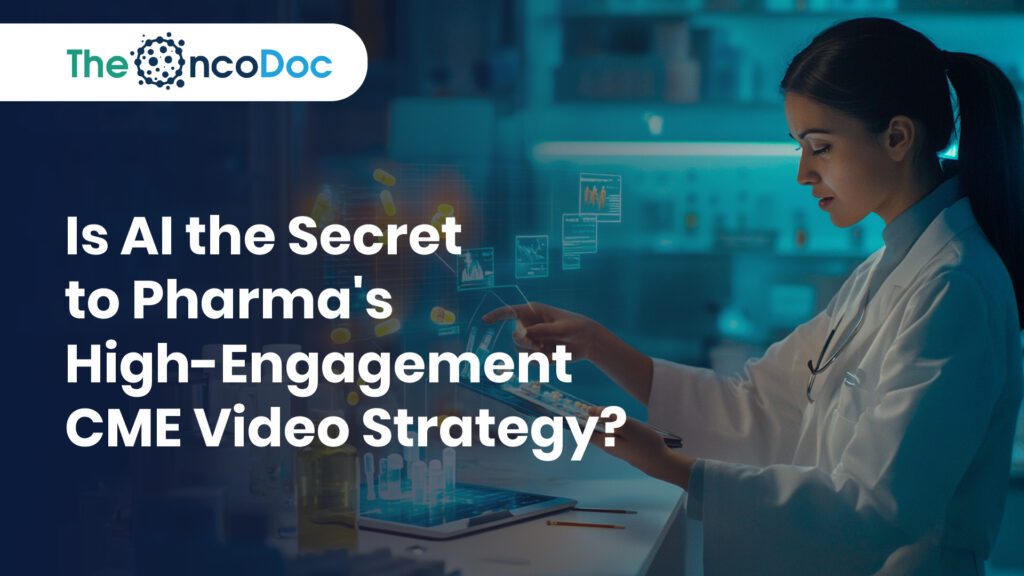Abstract
In the fast-paced, information-saturated world of oncology in the US, continuous medical education (CME) is crucial for healthcare professionals (HCPs) to stay current with scientific advancements and evolving clinical guidelines. While video has emerged as a preferred format for learning due to its accessibility and engaging nature, traditional CME videos often struggle to capture and sustain oncologists’ attention. Generic content, passive viewing experiences, and a lack of personalization contribute to low completion rates and limited knowledge retention. This article explores how Artificial Intelligence (AI) is poised to revolutionize CME video content, transforming it from a static educational tool into a high-engagement, purpose-driven asset that serves as “Pharma’s Secret to Engagement.”
We will delve into five key ways AI is enhancing CME video strategy: 1) AI-Powered Content Personalization and Micro-Learning Modules; 2) Interactive and Adaptive Video Experiences; 3) Real-Time Performance Analytics and Optimization; 4) AI-Driven Content Generation and Localization; and 5) Integrating Video with Omnichannel Engagement Pathways.
Each section will provide a detailed analysis of AI’s role, from leveraging natural language processing (NLP) and machine learning for content tailoring to employing computer vision for engagement analytics. Practical examples relevant to the US oncology market will illustrate how pharma managers can utilize AI to create CME video experiences that are not only highly relevant and digestible but also deeply engaging and impactful. The discussion will incorporate data-driven insights and hypothetical models to demonstrate the quantifiable benefits of AI-enhanced CME video, positioning it as a cornerstone of an evolved, AI-driven digital marketing strategy that fosters deeper learning, greater adherence to best practices, and stronger relationships between pharma and oncologists.
Introduction: The Shifting Sands of Medical Education and the Promise of Video
The landscape of medical education is undergoing a profound transformation. Oncologists in the US, facing immense time pressures and a relentless deluge of new scientific data, are increasingly gravitating towards flexible, on-demand, and visually engaging learning formats. Video, with its ability to convey complex information clearly and concisely, has naturally risen to prominence as a preferred medium for Continuing Medical Education (CME). From surgical technique demonstrations to expert panel discussions on novel therapies, video offers an immediacy and richness that text-based learning often cannot match.
However, simply putting a “talking head” expert or a static slide presentation on video is no longer sufficient. In an age dominated by highly polished, personalized, and interactive digital content from platforms like YouTube and TikTok, even professional educational videos must compete for attention. Traditional CME videos often suffer from a lack of personalization, passive viewing experiences, and an inability to adapt to individual learning needs. This leads to low completion rates, limited knowledge transfer, and ultimately, a missed opportunity for pharmaceutical companies to genuinely educate and engage their target audience.
This article argues that Artificial Intelligence is the critical missing piece, the “secret sauce,” that can elevate CME video from a conventional educational tool to a high-engagement, purpose-driven asset. By harnessing AI’s power to personalize, optimize, and interact, pharma marketers can create CME experiences that resonate deeply with oncologists, fostering enhanced learning, driving adoption of best practices, and building stronger, more meaningful connections. We will delve into how AI is enabling this transformation, focusing on five key use cases that are redefining the future of CME video in the US oncology market.
Use Case 1: AI-Powered Content Personalization and Micro-Learning Modules
The Problem
One-size-fits-all CME videos, while convenient to produce, often fail to address the specific learning gaps or interests of individual oncologists. A video on advanced melanoma treatments might be too basic for a melanoma specialist or irrelevant to a community oncologist primarily treating breast cancer. Long, undifferentiated videos also exacerbate time scarcity issues.
The AI Solution
AI enables hyper-personalization of video content, delivering precisely what an oncologist needs, in digestible micro-learning formats.
- Learner Profiling: Machine Learning algorithms analyze an oncologist’s digital footprint (previous video views, search queries on medical platforms, clinical trial involvement, sub-specialty, geographical practice patterns, anonymized prescribing behavior where permissible) to create a dynamic “learning profile.”
- Adaptive Content Sequencing: AI can then dynamically assemble personalized learning paths, recommending specific video segments or micro-modules based on the oncologist’s profile and identified knowledge gaps.
- Micro-Learning Generation: Generative AI, combined with NLP, can take a longer CME video and automatically extract key takeaways, create short summaries, or even generate follow-up quizzes or infographics to reinforce learning.
Practical Application in Oncology
A pharma company has a comprehensive 60-minute CME video on managing side effects of a new immunotherapy for lung cancer.
- Personalized Delivery: For a community oncologist who previously only viewed short clips on lung cancer screening, AI might recommend a 5-minute micro-module specifically on the initial recognition of common irAEs. For an academic oncologist who has completed a basic module, AI might suggest an advanced 10-minute segment on novel management strategies for refractory irAEs.
- Dynamic Playlists: Each oncologist receives a “personalized playlist” of video content, ensuring maximal relevance and respect for their time.
- Quantifiable Impact: Higher completion rates, increased satisfaction, and improved knowledge retention, leading to more confident and informed management of complex therapies.
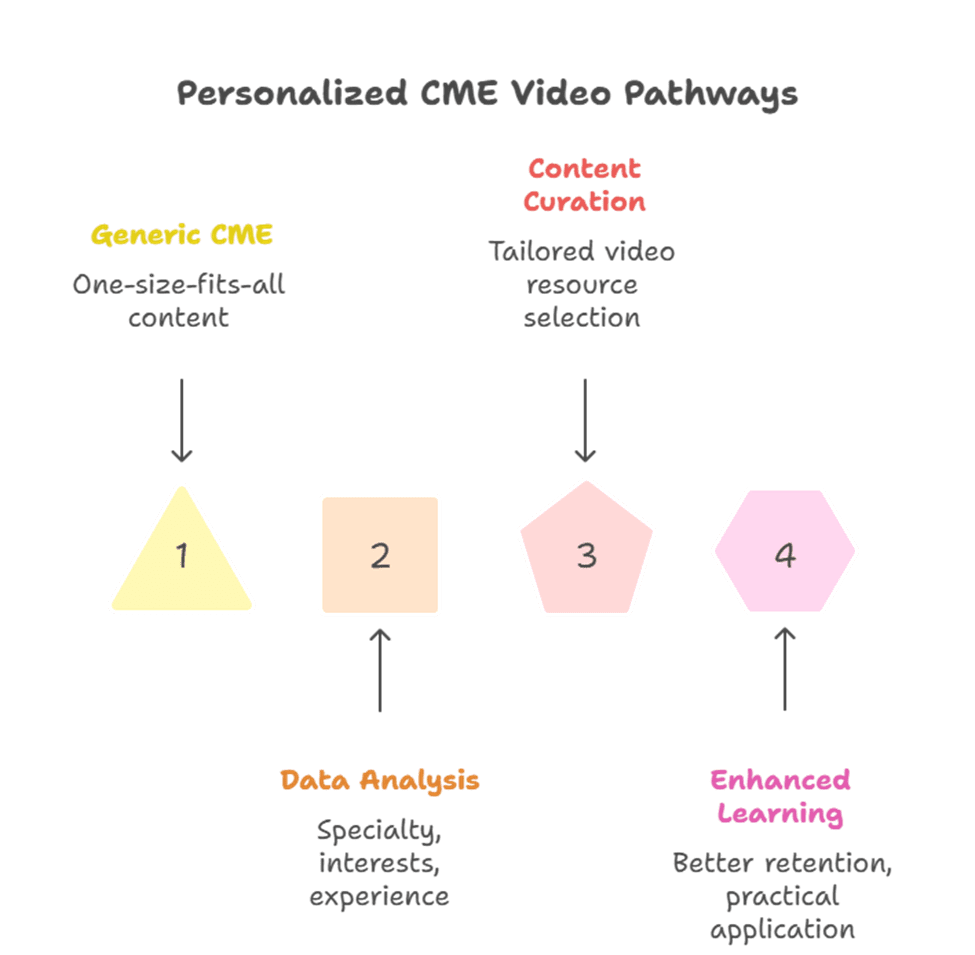
Use Case 2: Interactive and Adaptive Video Experiences
The Problem
Traditional CME videos are largely passive experiences. Viewers simply watch, often disengaging mentally. This lack of interaction limits active learning and makes it difficult for pharma to gauge true comprehension or areas of confusion.
The AI Solution
AI transforms static videos into dynamic, interactive learning environments that adapt in real-time to the learner’s engagement.
- In-Video Quizzes and Polls: AI can intelligently embed quick quizzes, polls, or questions directly within the video, pausing playback to prompt engagement. The questions can adapt based on previous answers, guiding the learner through areas of weakness.
- Branching Narratives: For complex case studies, AI can create branching video pathways. An oncologist might be presented with a patient scenario and asked to choose a diagnostic test or treatment option. The video then adapts, showing the outcome of their choice and providing expert feedback.
- Eye-Tracking and Emotion Detection (Opt-in): More advanced AI, with explicit user consent, can analyze eye-tracking or facial expressions (e.g., via webcam) to gauge attention levels and identify moments of confusion or strong engagement, helping to optimize future content.
Practical Application in Oncology
A pharma company presents a video on diagnostic algorithms for specific cancer biomarkers.
- Interactive Case Study: The video presents a patient case and pauses, asking the oncologist to select the next diagnostic step. Based on their choice, the video proceeds to either explain why that was the correct (or incorrect) choice, offering remedial content if needed, or advancing to the next stage of the case.
- “Click to Learn More”: Specific molecular pathways or drug mechanisms shown in the video can be made clickable, expanding into a brief pop-up or a linked micro-video for deeper dives without interrupting the main narrative for all viewers.
- Quantifiable Impact: Increased active learning, improved decision-making skills, and measurable data on areas where oncologists require more education.
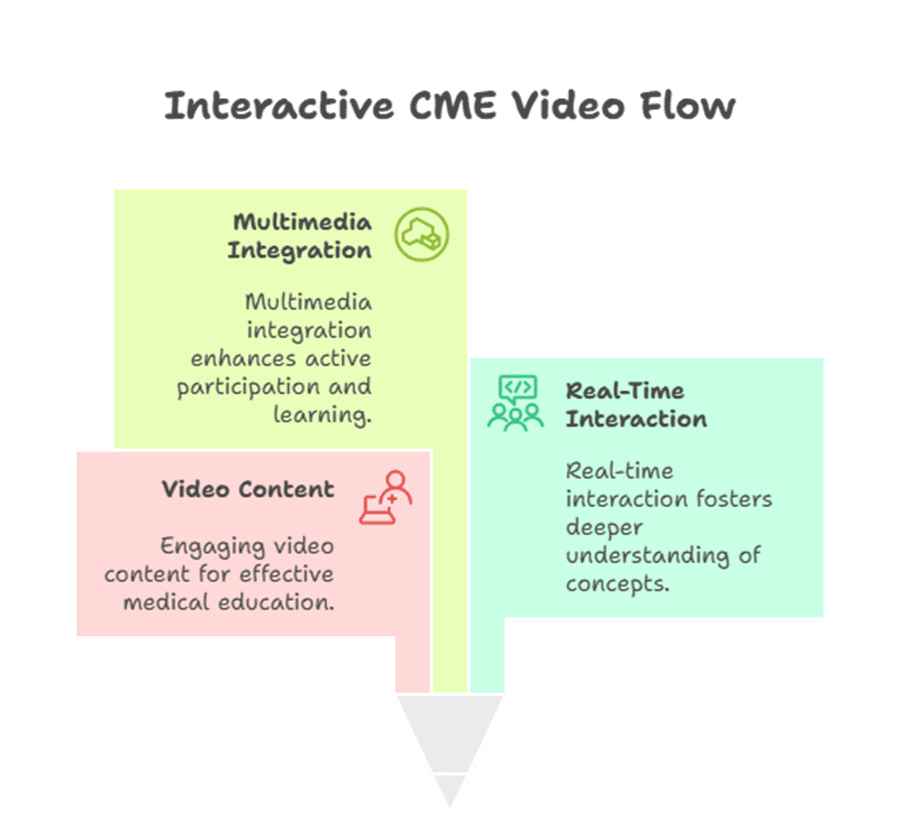
Use Case 3: Real-Time Performance Analytics and Optimization
The Problem
Measuring the true impact of CME videos is often limited to basic metrics like view counts and completion rates. Understanding why a video performed well or poorly, which segments of content were most engaging, or where viewers dropped off, is crucial for continuous improvement but difficult with manual analysis.
The AI Solution
AI provides deep, real-time analytics on video performance, identifying patterns and offering actionable insights for optimization.
- Engagement Heatmaps: AI can generate “heatmaps” of video engagement, showing which sections viewers re-watched, skipped, or paused on. This identifies the most (and least) compelling parts of the content.
- Drop-Off Analysis: AI identifies precise points where viewers disengage, allowing marketers to understand if specific content, a long monologue, or a complex graphic is causing loss of interest.
- A/B Testing and Predictive Optimization: AI can automatically run A/B tests on different video intros, calls-to-action, or content segments, predicting which variations will yield the highest engagement for specific oncologist profiles and dynamically optimizing content.
Practical Application in Oncology
A pharma company rolls out a series of CME videos on a new drug’s safety profile.
- Content Refinement: AI analysis reveals that oncologists consistently drop off during a 5-minute segment explaining a complex pharmacokinetic pathway. This signals that the content needs to be re-edited into a more digestible format or perhaps offered as an optional deep-dive.
- Personalized Follow-Up: AI identifies oncologists who watched only a portion of a video on adverse event management. It can then trigger a personalized email offering a short infographic summarizing key safety points, rather than pushing the full video again.
- Quantifiable Impact: Continuous improvement of video content, higher overall engagement, and more efficient allocation of content creation resources.
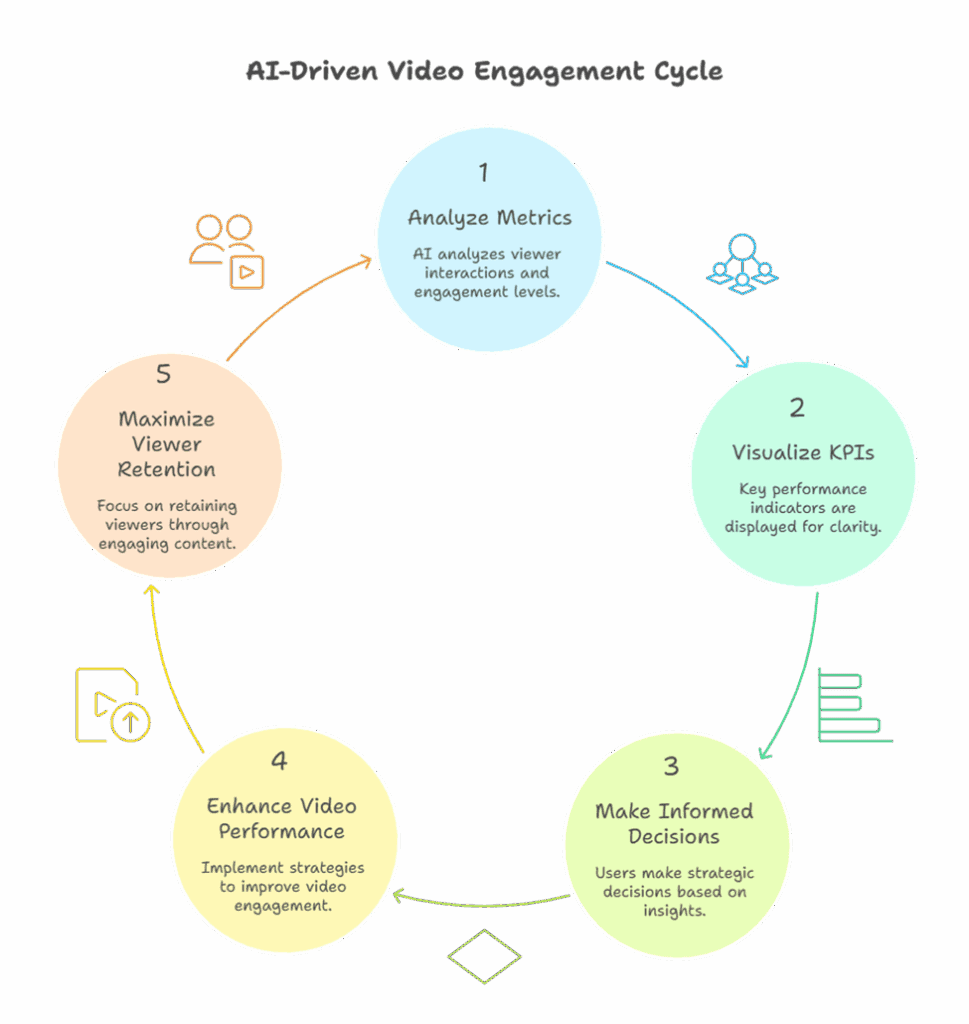
Use Case 4: AI-Driven Content Generation and Localization
The Problem
Creating high-quality, scientifically accurate video content is time-consuming and expensive. Adapting it for different audiences (e.g., global markets, sub-specialties with slightly different nuances) further escalates costs and timelines. Maintaining consistency and accuracy across multiple versions is a challenge.
The AI Solution
Generative AI is increasingly capable of assisting in video content creation, from scripting to localization, accelerating production and ensuring consistency.
- Script Generation and Refinement: AI can assist in drafting video scripts based on provided scientific data, ensuring accuracy and adherence to key messaging, potentially even adapting the tone for different target audiences (e.g., more technical for academic oncologists, more practical for community oncologists).
- Automated Narration and Voice-Overs: AI can generate high-quality, natural-sounding voice-overs in multiple languages, significantly reducing the cost and time associated with manual voice talent and localization.
- Visual Asset Generation: While nascent, AI can assist in generating simple graphics, data visualizations, or even basic animations for explainer videos, reducing reliance on expensive motion graphics teams for every asset.
- Compliance Pre-Screening: AI can pre-screen generated scripts for medical, legal, and regulatory (MLR) compliance, flagging potential issues before human review.
Practical Application in Oncology
A pharma company needs to create a series of CME videos for its global launch of a new anti-cancer drug.
- Multi-Language Content: Instead of recording separate voice-overs, the English script (once approved) is fed into an AI system that generates voice-overs in Spanish, Mandarin, German, etc., maintaining consistent pronunciation of scientific terms.
- Dynamic Data Visuals: For an animated graph showing efficacy data, AI can generate slightly different versions to emphasize specific endpoints relevant to different regions or sub-populations.
- Impact: Accelerated content production cycle, significant cost savings in localization, and greater consistency in global messaging, enabling faster market penetration and education.
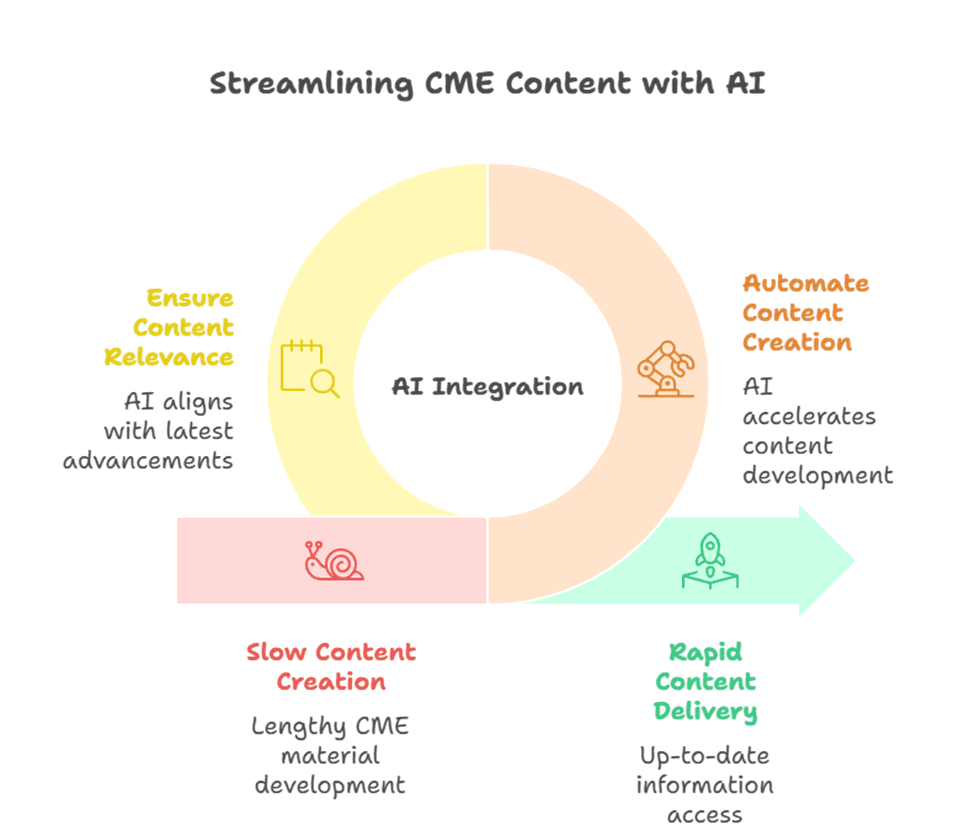
Use Case 5: Integrating Video with Omnichannel Engagement Pathways
The Problem
CME videos often exist in a silo, disconnected from other engagement channels. An oncologist might watch a video, but then receive a generic email or a sales rep visit that doesn’t acknowledge their learning journey or build upon the video’s content. This fragmented experience reduces overall engagement effectiveness.
The AI Solution
AI acts as an orchestrator, seamlessly integrating CME video consumption into a broader, personalized omnichannel engagement strategy.
- Contextual Follow-Up: AI can trigger personalized follow-up actions based on video completion, quizzes, or engagement metrics. If an oncologist completes a video on side effect management, AI might recommend a related article, invite them to a live Q&A with the video’s expert, or update the sales rep’s talking points for their next visit.
- Journey Mapping: AI maps the oncologist’s entire learning journey, recommending the next “best content” or “next best action” across any channel, ensuring that video is a cohesive part of a larger, evolving dialogue.
- Reinforcement Learning: AI can schedule periodic “booster” video micro-modules or quizzes based on the knowledge gained from a primary CME video, helping to reinforce learning and combat the “forgetting curve.”
Practical Application in Oncology
An oncologist views a CME video on new biomarker testing guidelines for a specific cancer.
- Seamless Transition: After watching, the AI recognizes their interest in the topic. It then pushes a notification to their preferred professional platform about an upcoming webinar on reimbursement for that specific biomarker testing, effectively moving them down the engagement funnel.
- Rep Enablement: The AI updates the sales rep’s CRM profile for that oncologist, noting their engagement with the video and suggesting they discuss current challenges in biomarker testing in their next interaction.
- Impact: Deeper, more sustained engagement, improved knowledge application in practice, and a more integrated, valuable relationship between pharma and oncologists.
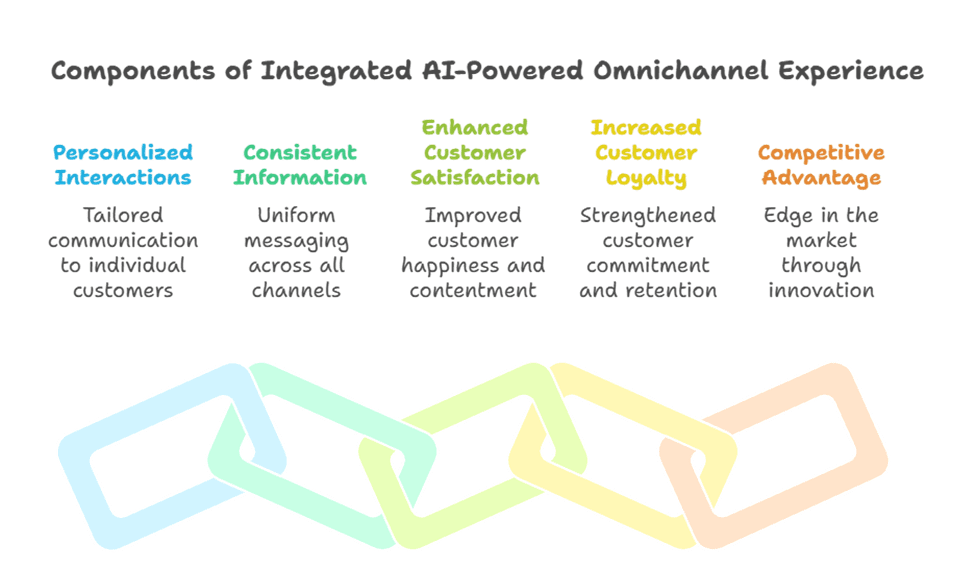
Conclusion: From Passive Viewing to Purposeful Engagement
The demand for relevant, timely, and engaging medical education has never been higher, especially within the dynamic US oncology market. While video offers an unparalleled medium for delivering complex scientific information, its potential has often been constrained by traditional, one-way delivery models. Artificial Intelligence is now unlocking video’s true power, transforming it from a static asset into a dynamic, personalized, and deeply interactive learning experience.
For pharma managers, this represents a significant opportunity to redefine their CME strategy. By leveraging AI for content personalization, interactive experiences, real-time optimization, smart generation, and seamless omnichannel integration, they can move beyond generic awareness to cultivate purposeful engagement that drives real impact. This means not just higher video completion rates, but also improved knowledge retention, better clinical decision-making, and ultimately, enhanced patient care in oncology.
The “secret to engagement” is no longer about just having video; it’s about making that video intelligent. AI empowers pharma to create CME content that truly resonates with oncologists, respects their time, and becomes an indispensable part of their continuous professional development. The future of CME video is intelligent, personalized, and, thanks to AI, incredibly engaging.
The Oncodoc team is a group of passionate healthcare and marketing professionals dedicated to delivering accurate, engaging, and impactful content. With expertise across medical research, digital strategy, and clinical communication, the team focuses on empowering healthcare professionals and patients alike. Through evidence-based insights and innovative storytelling, Hidoc aims to bridge the gap between medicine and digital engagement, promoting wellness and informed decision-making.

